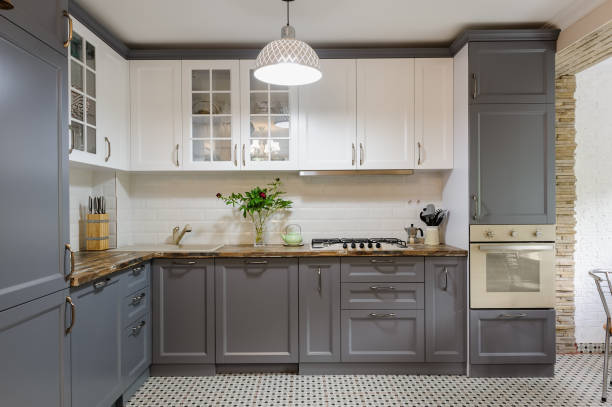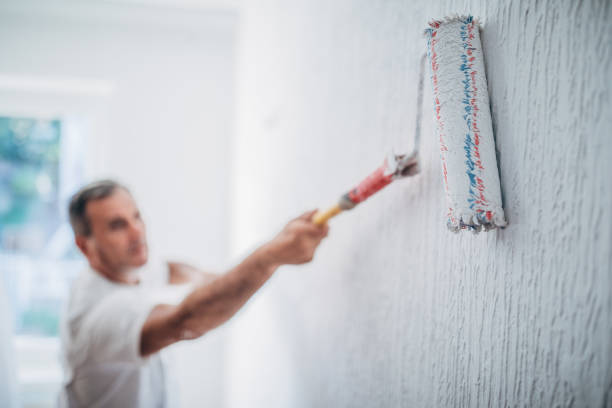Deciding on a color scheme for the walls of your abode or business is an essential determination that can have an immense influence on the aesthetic and atmosphere of any area. But when it comes to choosing paint, there are so many options out there. One option you may be considering is cabinet paint - but before you make this choice, it's important to ask yourself: Can you use cabinet paint on walls?
While using cabinet paints for wall painting projects has its advantages in certain situations, they also come with their own set of considerations. In this blog post, we'll explore these pros and cons as well as alternatives to whether can you use cabinet paint on walls and why professional painting services might be best for your project.
Table of Contents
Cabinet paint is a type of interior wall and furniture coating specifically designed to be used on cabinets. Cabinet paint is tougher than standard wall coatings, providing superior defense against everyday wear and tear like scratches, dents, fading, etc. Cabinet paint comes in many different varieties depending on the desired finish and level of protection needed.
There are two main types of cabinet paint available - water-based acrylics and oil-based alkyds. Water-based acrylics offer a sleek finish that resists damage from chipping, flaking, or peeling off in the long run and is also effective for sticking to surfaces such as wood or metal, therefore, making it a common choice to paint kitchen cabinets. Oil-based alkyds offer superior durability but require more preparation work before the application due to their thicker consistency.
Painting kitchen cabinets using cabinet paint can help protect your cabinets from wear and tear while also giving them an attractive look with minimal effort required for maintenance over time. This type of paint is highly resistant to moisture which helps prevent warping or swelling caused by humidity changes in the environment as well as preventing mold growth if exposed to water spills frequently encountered in kitchens or bathrooms. In addition, it provides excellent coverage with just one coat allowing you to save money on multiple coats necessary for traditional paints when covering large areas such as entire walls or rooms quickly without sacrificing quality results.
The most common use for cabinet paints is painting kitchen cabinets since they are often subject to frequent contact with food particles which can lead to staining if not properly sealed off from potential sources of contamination such as grease splatter from cooking activities. Other uses include painting cabinets of bathroom vanities, wardrobes, bookshelves, armoires, entertainment centers, filing cabinets, desks, chairs, and tables; all of which may be exposed to dampness due to their proximity near sinks.

(Source)
Cabinet paint is a specially formulated coating that can give painted cabinets extra strength and protection, making it perfect for adding an attractive touch to any kitchen or bathroom. However, the question remains: can you use cabinet paint on walls or is it really just for cabinets? We'll delve deeper into the pros and cons of utilizing this distinctive paint on kitchen cabinet painting projects and other indoor surfaces.
Using cabinet paint on walls is a popular choice for interior painting projects, as it offers an attractive finish that can last for years. Cabinet paint, which is commonly used in kitchen cabinet painting project, has several advantages over regular wall paints, including better coverage and durability. Nevertheless, there are some downsides to utilizing cabinet paint on walls; such as the necessity for more prepping and the potential of discoloration if not applied correctly.
With careful planning and attention to detail, you can use cabinet paint on walls with excellent results.
Cabinet paint is formulated with a higher concentration of resin than wall paints, giving it increased durability and resistance to damage. It typically contains higher concentrations of resin than wall paints do, which makes it harder and more resistant to damage. In addition, many brands offer superior coverage compared to standard wall paints; this means fewer coats will be needed when painting cabinets or other surfaces in your home or business space.

(Source)
Finally, because it's specifically formulated for cabinets rather than general household surfaces like walls or trim pieces, you'll get an even smoother finish without having to worry about brush marks showing through after drying time has elapsed.
Due to its robustness, any missteps during the application process could lead to permanent staining that can only be remedied through extensive sanding; therefore, it is of utmost importance to ensure that everything is adequately prepped before commencing. With this in mind, one should bear in mind that using cabinet paint on walls may require additional supplies such as primer which could add up cost-wise at the end of the day.
Cabinet paint can be a potential option for decorating walls, but it is essential to weigh up the advantages and drawbacks before settling on this approach. Alternatives such as interior wall paints, specialty wall paints, and textured wall finishes are also available that may provide better results in certain situations.
When it comes to painting walls, there are many alternatives to using cabinet paint. Interior wall paints boast a range of hues and finishes that can be employed in any room or space.
Specialty wall paints provide unique textures and effects that can add interest to any area. And textured wall finishes create an interesting look with raised patterns or designs.
These paints also come in various sheens such as flat, eggshell, satin, and semi-gloss which offer different levels of shine depending on your preference. Additionally, interior wall paints often contain special additives like mildewcide which help prevent mold growth on walls and ceilings.
Specialty wall paints are designed for specific purposes such as creating decorative effects like sponging or rag rolling techniques; hiding surface imperfections; providing waterproof protection; increasing fire resistance; blocking UV rays; reducing sound transmission between rooms; etcetera With specialty paint products you can achieve creative results without having to hire professional painters.

(Source)
Textured wall finishes give walls an interesting look by adding raised patterns or designs through troweling techniques applied with specialized tools while the finish is still wet. The end result is a unique texture that adds visual appeal while also helping hide minor surface imperfections - great for busy areas where scuffs and marks may occur. For those looking for something more permanent than wallpaper but less expensive than tilework, this could be the ideal solution.
It is important to consider the various alternatives to using cabinet paint on walls, such as interior wall paints, specialty wall paints, and textured finishes. For a top-notch outcome for your home or business, consider hiring professional painters to do the job with exactness and excellence.
No, Behr cabinet paint is not recommended for use on walls. This type of paint is designed to be used specifically on cabinets and other wood surfaces due to its high gloss finish and resistance to moisture.
For interior wall painting, a latex or acrylic paint designed for walls should be used to ensure proper coverage and an aesthetically pleasing finish. It will provide the necessary coverage while still allowing your walls to breathe properly and look great when done.
Yes, cabinet paint is different than regular paint. Cabinet paint is formulated to adhere well and provide a durable finish when exposed to moisture and heat, such as in kitchens. It also has a tougher finish than regular wall paints which helps protect against wear and tear from daily use of the cabinetry.
Regular interior wall paints may not be able to withstand the same level of exposure or provide enough protection for your cabinets over time.
Wood paint is created to be applied on wood surfaces, while wall paints are made for use on walls. Wood paint contains ingredients that protect the wood from moisture and UV damage, as well as provide a durable finish.
Wall paints contain binders that adhere to the surface of walls and provide even coverage with fewer coats than would be required with other types of paints. Additionally, wall paints are usually more washable than wood paints due to their higher levels of resins or polymers which make them resistant to dirt and stains.
A common question among homeowners and business owners alike is "can you use cabinet paint on walls?".
Though it might be possible to employ cabinet paint on walls, there are other alternatives that could give superior results when used for interior painting. Hiring professional painting contractors is the best way to ensure you get the best results when deciding whether to use the same type of product on cabinets as on interior or exterior surfaces. They can help you determine which products are best for each application so you get the most value out of your investment in deciding "can you use cabinet paint on walls".
Let Pristine Painters help you determine the best type of paint for your walls. Our experienced contractors can provide quality painting solutions to ensure a perfect finish every time. Click here to schedule a consultation.